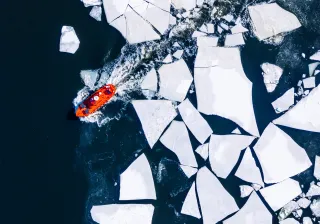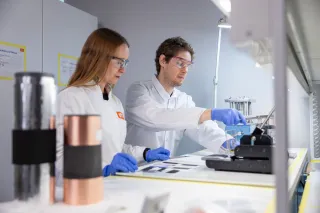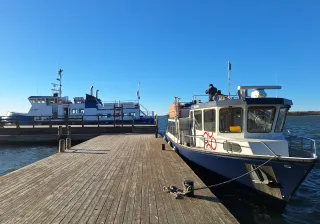To meet the climate targets set for shipping, we must first look at the energy efficiency of vessels. There are a number of ways in which emissions can be cut, but they need to be implemented in practice. Technology and innovation provide opportunities for overcoming challenges.
Lowering greenhouse gas emissions and pollution caused by maritime transport is a major undertaking. The United Nation's International Maritime Organisation (IMO) is looking to halve emissions by 2050. Ships are vital for the movement of people and goods: ninety per cent of the world's trade is transported by water.
Emissions are already under strict surveillance. The IMO has ruled that, from January 2020, emissions of sulphur, nitrogen and other fine particles must be slashed by introducing cleaner fuels and various kinds of marine exhaust gas cleaning systems, such as sulphur scrubbers.
The new rules put major pressure on all parties. Compliance requires radical changes to ships' power output systems, which are only possible with new innovations and investment. On the other hand, ships must be powerful enough to operate safely in all weather conditions.

– Vetykaasu sopii isohkot laivueet omistaville, paikallisesti tai säännöllisillä reiteillä toimiville varustamoille, tutkija Jyrki Mikkola (vas.) selostaa.
All possible means must be employed
According to Johannes Hyrynen, Vice President of VTT Mobility and Transport, all possible means must be employed to meet the climate targets. He believes that the first area to explore should be alternative fuels.
- Hydrogen and electricity produced from renewable sources of energy are very promising marine fuels. Biofuels and synthetic fuels also have a future. Ships without a combustion engine will not be a viable option for a while, if only for safety reasons. However, machinery is becoming cleaner and cleaner all the time, Hyrynen says.
The growing use of liquefied natural gas (LNG) is a step in the right direction. Although its carbon dioxide emissions are lower than those of traditional fuels, LNG is still nevertheless a fossil fuel, and other solutions must be introduced in the long term.
Structural experiments in a laboratory environment
Hyrynen believes that there is also room for innovation in ships' propulsion and propeller systems. New propeller concepts can offer considerably higher efficiency than their traditional counterparts. The market has also already seen other solutions that make the operation of ships more efficient. One good example is a rotor sail developed by a Finnish company called Norsepower, which has already shown that an auxiliary wind propulsion system saves fuel and therefore helps to reduce emissions.
- In addition to fuels and propulsion systems, we need to pay more and more attention to engineering solutions that affect energy consumption. We are currently running laboratory-scale experiments on hydrodynamics and building complex theoretical models of propellers and hulls of different shapes. Understanding a ship's behaviour in rough seas and minimising water resistance are crucial.
Businesses, research centres and universities have begun to work together to optimise energy consumption. One such collaboration is a project called INTENS, which seeks to promote and integrate digitalisation into the maritime-sector value chain from R&D to innovation, design, manufacturing and operation. The team is hoping to come up with new solutions to improve the energy efficiency of ships and to cut emissions. The project is also expected to create new, groundbreaking operating models and business opportunities.
Future ambitions include combining the functions of a navigation simulator and an energy simulator to study the effect of different kinds of manoeuvres on a ship's energy efficiency.
Hyrynen also sees potential in new kinds of navigation systems and more efficient routing enabled by automation, artificial intelligence and autonomous ships. Digitalisation will undoubtedly affect the logistics of shipments and therefore reduce emissions.
Hydrogen powers ships where batteries are not enough
VTT's Research Scientist Jyrki Mikkola coordinates a European innovation project called FLAGSHIPS, which studies the use of hydrogen as a fuel for different kinds of vessels. The project team consists of a Norwegian ferry and a French push-boat as well as Finnish experts from VTT and ABB.
The French vessel will be operated by a shipping company called CFT, and it will serve as a utility vessel in Lyon. The second hydrogen vessel will be operated by a shipping company called Norled as part of the local public transport network in Stavanger. Both vessels will be used daily by the operators. VTT has always maintained that shipping companies play a key role in these kinds of projects.
- The Norwegians' hydrogen production technique is based on hydropower, which in this case can be used to power a ferry. The ferry's meandering route, long daily operating hours and tight schedule are a combination that rules-out battery-powered vessels. The French vessel will operate on a river in the heart of Lyon, and there is growing pressure for France to ban heavy transport in city centres in order to curb air pollution, Mikkola explains, adding that using hydrogen as a versatile energy carrier is one of the hot topics in EU at the moment.
Hydrogen fuel breaks down into water and heat
Hydrogen is one of the currently available methods of increasing the flexibility of renewable electricity production. Hydrogen can be made by breaking down water into hydrogen and oxygen using electricity, and both products have a healthy market. When electricity prices are low, renewable electricity producers can therefore turn their electricity into hydrogen and sell it to be used as, for example, raw materials for the industrial sector or a zero-emission transport fuel. The latter can potentially fetch a much higher price than the former.
- Since the production cost per kilogram of hydrogen drops with higher volumes, hydrogen gas is a good option for shipping companies with relatively large fleets that operate local or regular services, Mikkola says.
- Hydrogen can be used in on-board fuel cells to produce electricity, heat and water. The produced electricity can then be used, for example, to power the ship's propellers. He also points out an interesting fact about the Finnish translation of a fuel cell.
- We Finns call them "polttokennot", which directly translates to combustion cells, even though there is no flame involved. The process is based on electrochemical oxidation. There are no fuel cell manufacturers in Finland, and our nearest supplier is based in Sweden. They are called PowerCell, and we work in close cooperation with them.
In addition to the EU's FLAGSHIPS project, VTT is also participating in another European research project that involves a research vessel called Aranda. VTT is in charge of building a hydrogen-powered fuel cell system, which will act as an auxiliary power source on board the ship.
- This is a hugely challenging undertaking. The fuel cell system needs to be retrofitted, and it will be located on the ship's deck, fully exposed to the hard conditions at sea. However, if we can make the system work on board Aranda, we know that it can also be used to produce zero-emission electricity on board all other kinds of vessels, Mikkola says.






